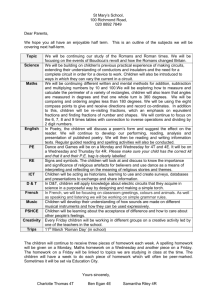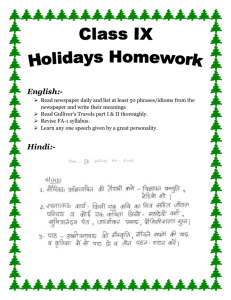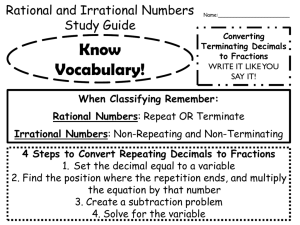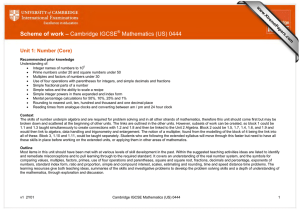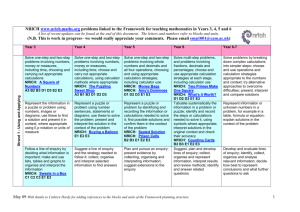UNIT 1 NUMBER AND ALGEBRA - Papers
advertisement
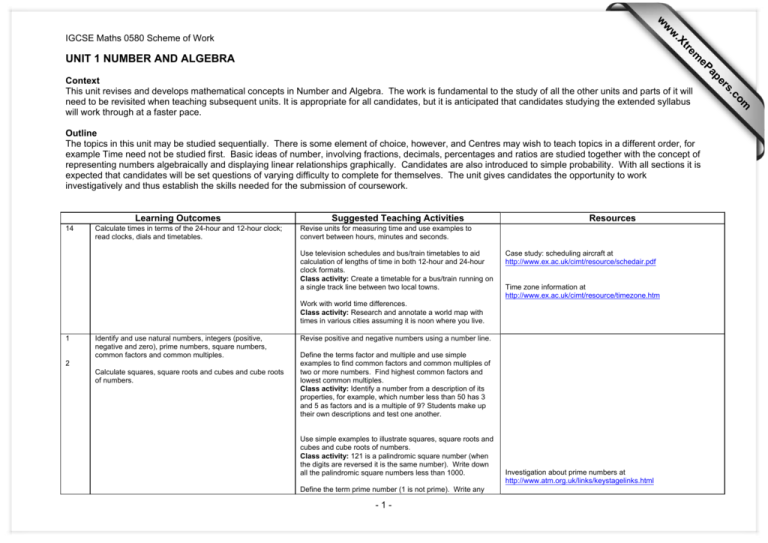
w w w e tr .X IGCSE Maths 0580 Scheme of Work Outline The topics in this unit may be studied sequentially. There is some element of choice, however, and Centres may wish to teach topics in a different order, for example Time need not be studied first. Basic ideas of number, involving fractions, decimals, percentages and ratios are studied together with the concept of representing numbers algebraically and displaying linear relationships graphically. Candidates are also introduced to simple probability. With all sections it is expected that candidates will be set questions of varying difficulty to complete for themselves. The unit gives candidates the opportunity to work investigatively and thus establish the skills needed for the submission of coursework. Learning Outcomes 14 Calculate times in terms of the 24-hour and 12-hour clock; read clocks, dials and timetables. Suggested Teaching Activities Resources Revise units for measuring time and use examples to convert between hours, minutes and seconds. Use television schedules and bus/train timetables to aid calculation of lengths of time in both 12-hour and 24-hour clock formats. Class activity: Create a timetable for a bus/train running on a single track line between two local towns. Case study: scheduling aircraft at http://www.ex.ac.uk/cimt/resource/schedair.pdf Time zone information at http://www.ex.ac.uk/cimt/resource/timezone.htm Work with world time differences. Class activity: Research and annotate a world map with times in various cities assuming it is noon where you live. 1 Identify and use natural numbers, integers (positive, negative and zero), prime numbers, square numbers, common factors and common multiples. 2 Calculate squares, square roots and cubes and cube roots of numbers. Revise positive and negative numbers using a number line. Define the terms factor and multiple and use simple examples to find common factors and common multiples of two or more numbers. Find highest common factors and lowest common multiples. Class activity: Identify a number from a description of its properties, for example, which number less than 50 has 3 and 5 as factors and is a multiple of 9? Students make up their own descriptions and test one another. Use simple examples to illustrate squares, square roots and cubes and cube roots of numbers. Class activity: 121 is a palindromic square number (when the digits are reversed it is the same number). Write down all the palindromic square numbers less than 1000. Define the term prime number (1 is not prime). Write any -1- Investigation about prime numbers at http://www.atm.org.uk/links/keystagelinks.html om .c Context This unit revises and develops mathematical concepts in Number and Algebra. The work is fundamental to the study of all the other units and parts of it will need to be revisited when teaching subsequent units. It is appropriate for all candidates, but it is anticipated that candidates studying the extended syllabus will work through at a faster pace. s er ap eP m UNIT 1 NUMBER AND ALGEBRA IGCSE Maths 0580 Scheme of Work integer as a product of primes. Class activity: Investigate Goldbach’s conjecture. Goldbach’s conjecture and assorted problems at http://www.utm.edu/research/primes/notes/conjectures/ Weather statistics for over 16000 cities at http://www.weatherbase.com/ 3 Use directed numbers in practical situations. Use a number line to aid addition and subtraction of positive and negative numbers. Illustrate by using practical examples, e.g. temperature change and flood levels. 4 Use the language and notation of simple vulgar and decimal fractions and percentages in appropriate contexts; recognise equivalence and convert between these forms. 7 Use the four rules for calculations with whole numbers, decimal fractions and vulgar (and mixed) fractions, including correct ordering of operations and use of brackets. Revise long multiplication, short and long division, and the order of operations (including the use of brackets). Use examples which illustrate the rules for multiplying and dividing by negative numbers. Class activity: Use four 4’s and the four rules for calculations to obtain all the whole numbers from 1 to 20. Revise equivalent fractions. Use this idea to aid addition and subtraction of fractions. Revise multiplication and division of fractions and convert between fractions, decimals and percentages. Use place value (units, tenths, hundredths etc.) to change a simple decimal into a fraction. 11/12 Calculate a given percentage of a quantity; express one quantity as a percentage of another; calculate percentage increase or decrease. Solve simple problems involving percentages, interpreting a calculator display in calculations with money. 20 Use letters to express generalised numbers and express basic arithmetic processes algebraically, substitute numbers for words and letters in formulae; transform simple formulae; construct simple expressions and set up simple equations Revise simple algebraic notation, for example, ab and x2 . Writing decimals as fractions at http://www.ex.ac.uk/cimt/resource/decimals.htm Substitute numbers into a formula (including formulae that contain brackets). Class activity: Investigate the difference between simple algebraic expressions which are often confused, for 2 example, find the difference between 2x , 2 + x and x for different values of x . Transform simple formulae, e.g., rearrange y = ax + b to make x the subject. Solve simple linear equations in one unknown. 24 Use straightforward examples to show how to solve simple linear equations, e.g. 3x + 2 = -1. Try the ‘Pyramid’ investigation at http://nrich.maths.org/public/leg.php 1 Identify and use rational and irrational numbers, real numbers. Define the terms real, rational and irrational numbers. Show that any recurring decimal can be written as a fraction. Show that any root which cannot be simplified to an integer or a fraction is an irrational number. Information about rational and irrational numbers at http://nrich.maths.org/public/leg.php 1 Continue a given number sequence; recognise patterns in sequences and relationships between different sequences, generalise to simple algebraic statements (including expressions for the nth term) relating to such sequences. Define a sequence of numbers. Work with simple sequences, e.g. find the next two numbers in a sequence of even, odd, square, triangle or Fibonacci numbers, etc. Find the term-to-term rule for a sequence, e.g. the sequence 3, 9, 15, 21, 27, .... has a term-to-term rule of +6 Various problems involving sequences of numbers at http://nrich.maths.org/public/leg.php Find the position-to-term rule for a sequence, e.g. the nth -2- IGCSE Maths 0580 Scheme of Work term in the sequence 3, 9, 15, 21, 27, .... is 6n - 3 . Class activity: Square tables are placed in a row so that 6 people can sit around 2 tables, 8 people can sit around 3 tables, and so on. How many people can sit around n tables? 17 Demonstrate familiarity with Cartesian coordinates in two dimensions. Revise coordinates in two dimensions. Class activity: For candidates studying the core syllabus, draw a picture by joining dots on a square grid. Draw x and y axes on the grid and note the coordinates of each dot. Ask another student to draw the picture from a list of coordinates only. 18 Construct tables of values for functions of the form ax + b where a and b are integral constants; draw and interpret such graphs; find the gradient of a straight line graph. Draw lines x = constant and y = constant. Draw a straight line graph from a table of values. Use simple examples to show how to calculate the gradient (positive, negative or zero) of a straight line from a graph. The gradient should be expressed as a fraction or a decimal. Use these results to consider the gradient of the line x = constant. 10 Demonstrate an understanding of the elementary ideas and notation of ratio and direct proportion; divide a quantity in a given ratio. Graphing linear equations at http://www.math.com/school/subject2/lessons/S2U4L3GL.html Define the term ratio and use examples to illustrate how a quantity can be divided into a number of unequal parts. Write a ratio in an equivalent form e.g. 6:8 can be written as 3:4, leading to the form 1:n . Solve problems involving direct proportion by either the ratio method or the unitary method. 34 Calculate the probability of a single event as either a fraction or a decimal (not a ratio). Understand and use the probability scale from 0 to 1. Understand that : the probability of an event occurring = 1 – the probability of the event not occurring; Understand probability in practice e.g. relative frequency. Discuss probabilities of 0 and 1, leading to the outcome that a probability lies between these two values. Class activity: Calculate probabilities based on experiment. For example, investigate whether a coin is biased. Use theoretical probability to predict the likelihood of a single event. For example, find the probability of choosing the letter M from the letters of the word MATHEMATICS. -3- Various problems involving probability at http://www.nrich.maths.org/public/leg.php

